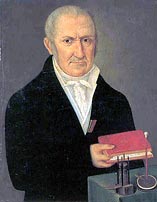![]()
![]()
During the seventeenth century there was much confusion about electricity. What was thought to be electric fluid was created by rubbing insulators and transported using metals. Pieter van Musschenbroek (1692-1761) in Leyden, Holland, wondered if it might be possible to store electric fluid in water. In 1745 as he cranked a sulfur ball, electric fluid flowed down a metal gun barrel, then down a metal wire into a flask of water held by his assistant. When the assistant touched the gun barrel with his free hand, a large spark shocked the assistant. Soon such devices known as Leyden jars soon became widely used o store electrical fluid. Electric sparks form Leyden jars killed several people.
Today we understand that the key components of every Leyden jar is an insulator (the glass jar) sandwiched between two conductors ( inside the original was impure water with outside the salty water with the assistant's hand). It is more common to new make Leyden jars with thin layers of metal inside and outside glass jars. Because the ability to store charge depends on the conductor surface area, it is common to roll sandwiches of metal sheets and thin insulators into compact devices called capacitors. Because of the energy such devices can contain, treat capacitors with much caution.
Benjamin Franklin tried to cook a turkey with electricity stored in Leyden jars but accidentally shocked himself.& He survived but noted the chest pain lasted for days. Franklin thought that lightning might resemble the sparks he made. He also survived his famous kite experiment while several others died trying the obtain evidence.


In Bologna, Italy, Luigi Galvani (1737-1799 at left) had been investigating since 1780 the connection between electricity and muscle contraction using frog legs. To further investigate electricity in the atmosphere, Galvani used frog legs suspended by brass hooks from the iron lattice supporting hanging gardens around his house. He found occasional muscle contractions both in thunderstorms and during serene weather. Brought inside the muscle contractions also occurred when the brass hooks touched an iron plate. When other metals surprisingly cause more violent contractions, he suspect the electricity was inherent in the animal itself.
Alesandro Volta (1745-1827 at right) read Galvani's report and thought the twitching muscles were not due to animal electricity, but rather electricity caused by a reaction of the metal hooks with a second metal of the cupboard something similar to the Leyden jar. In 1800 when a sandwich of two different metal disks such as copper and zinc separated by a wet pasteboard spacer provided inconclusive results, he pilled up a battery of sandwiches. (See below.) Simultaneously touching both the top and bottom metal disks a distinct shock was felt. Volta's battery revolutionized the study of electricity, provided a powerful new tool for chemistry, and start the radically changes society that continues today. For the first time it was possible to make a steady current flow of electricity rather than rely on erratic, short lived, occasional sparks.
 Equipment and supplies:
Equipment and supplies:
There are a number of features of electricity worth understanding. The following procedures are designed to help that understanding.
Finally, record your procedures, measurements, and findings in your journal. If you need course credit, use your observations recorded in your journal to construct a formal report
![]()
to next Experiment
to ie-Physics menu
to site menu